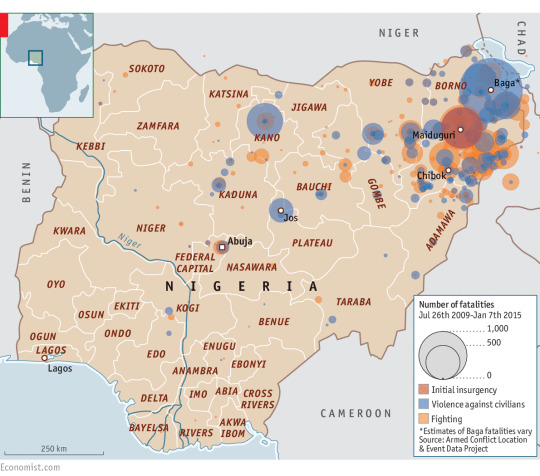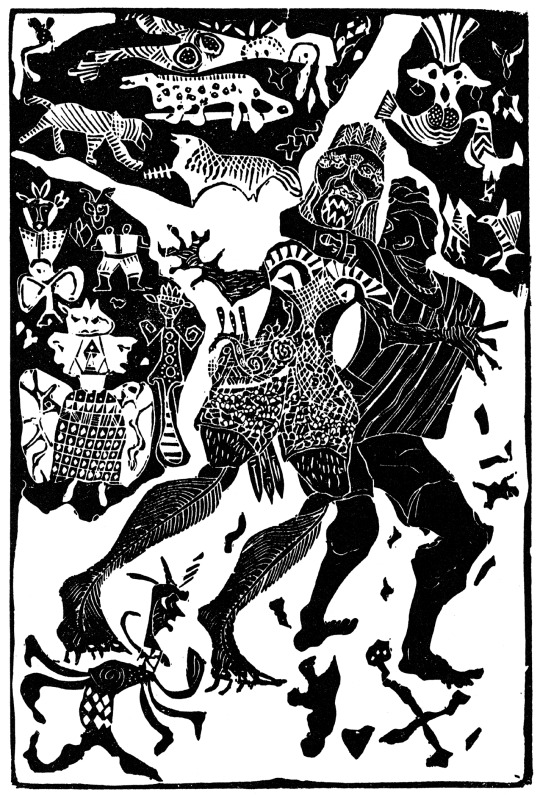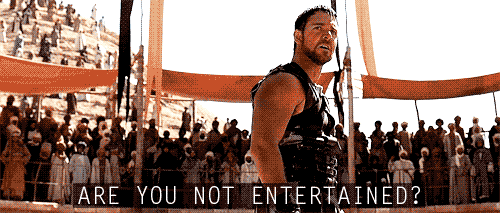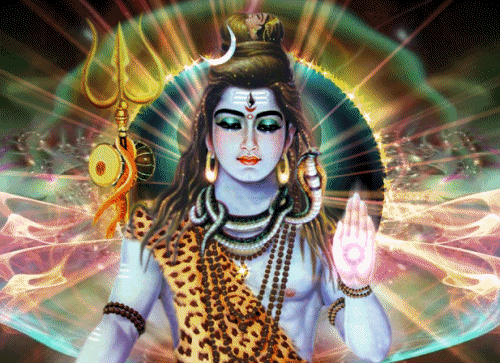Don't wanna be here? Send us removal request.
Text
Robert Cutler-Blog Entry 5
The documentary I watched was on the Boko Haram terrorist group in north Nigeria. The group’s name translates roughly to ‘western Education is a sin’. They are a radical Islamic group that seeks to separate themselves from the teaching of western influence. When the British Empire controlled the area and forcibly united the mostly Islam north and mostly Christian south in the 1900s, it created the conflict that brought about the group as it is today.
The film discussed the problems not only with the terrorist group, but with the military as well. The militias that were formed to find these terrorists might actually be doing more harm than help. In order to find their targets, the military is standing by as people are tortured by the militia in hopes of having them reveal they are members of Boko Haram. The people who don’t confess are beaten until they are unconscious and even after. The film shows videos that were taken and interviews of previous civilians and militia members who are telling their story on how they believe the militia is going about it the completely wrong way. In getting people to confess, they are actually causing innocent people to confess to the crimes that they didn’t commit.
It is interesting to note that in the comment section on YouTube, one user called the makers of the documentary ‘terrorist sympathizers’ for trying to show the abuse of power within the military.
I think that the documentary does show a western bias. They attempted to mitigate that bias by showing interviews from actual people affected by the terrorist group, but it still comes across that the problems being explained to us are thought of from a western influence. One of the main scenes is the clips of the events being shown to a guy who is knowledgeable on international laws who explains why these things are not allowed on a national scale.
This is connected to what we discuss in class because it shows the direct influence and instability caused in Africa after the great civilizations collapse and Europeans come to colonize.

0 notes
Text
Robert Cutler-Historic Fiction Review: Part 2
I chose to write my post about the book Forest of a Thousand Daemons. The book was written in 1938 by a Nigerian author Daniel Olurunfemi Fangunwa Ogboju in the Yoruba language. This was the first novel written in the Yoruba language and one of the first written African novels of all time. There were notes by the translator in the beginning of the novel that showed how he had issues translating directly into English. The direct translation of the title would be The Brave Hunter in the Forest of 400 Deities, but their concept of ‘400’ is similar to our idea of ‘a thousand’ or just ‘a lot’ and their idea of ‘deities’ is closer to ‘spirits’ than actual gods. The translator also describes the author’s style of writing with “Fagunwa’s style fluctuates, for he is both the enthusiastic raconteur and pious moralist, and the battle of the inventive imagination with the morally guided is a constant process in much of his work”. This shows that stories in this culture were also to give guidance rather than just to entertain.
The story starts off with the narrator relaxing at home when an old man comes up to chat. The man named Akara-ogun eventually explains to the narrator he needs his story written down for future generations to read so his story can serve as an example and guidance for future generations. The novel then goes in depth into his story as a great hunter and wielder of spells. This is very reminiscent to what we learned in class about the griots around the same region of Africa, where they tell stories within stories. It should also be noted that the story told by Akara-ogun is part storytelling and part preaching values and morals, similar to what priests would have done in Christian culture. Throughout the story, the narrator meets many mythological creatures and even has a fight with a 16 eyed spirit named Agbako where his arm is cut off and then mended by the spirit. One interesting part of the story is that Akara-ogun uses a gun to hunt. It shows the blending of modern objects and ideas into what would otherwise be a story about an ancient society.
It is also important to consider how often God is mentioned throughout this story. He is described like he is in Christian stories, passing judgement on people of the world and being the creator of everything and everyone. He even influences the lives of people in a specific town called ‘Filth’. They committed an unspecified “very evil deed” that is described as “so evil that the sun did not shine for six entire months, nor did the moon emerge for three whole years; the rain fell no more and the corn did not come to fruit, the yam did not sprout and plantains refused to ripen”. It shows how Christianity was a powerful influence on the people in West Africa at the time this was written.
The story isn’t meant to be factual, so it would not be a good historical document. However, many themes in the story can be used to get more detail into the beliefs and values of the people in the area at the time this was written.

The Image shows Akara-ogun on the right fighting the16 eyed spirit Agbako while forest daemons look on
0 notes
Text
Robert Cutler-Blog Post 4
The documentary I watched was about Qin Shi Huang, first emperor of China. He was originally born as Ying Zheng or Zhao Zheng, but changed his name to ‘Qin Shi Huang’, meaning the first, heavenly, divine emperor. He became king of the Qin kingdom, and was first under a regency lead by Lu Buwei. Lu Buwei was involved in a relationship with the king’s mother, and was banished because of it. Another man, Lao Ai, attempted to take over the country and put his sons (who he had with the queen) on the throne. He stole military seals and sent a force into the palace to kill the king, but it failed. He was later found and executed by being tied to five horse carriages and ripped to five pieces. His children were also killed, and Ying Zheng put his mother into house arrest until her death. This was the first instance of not only cruelty, but a willingness to do whatever it took to keep power and destroy his enemies.
After dispelling the attempted military coup, the king went on to conquer and unite all the warring states of China into one country. Rather than treat his prisoners well, he executed them to save time and speed up his war machine. From modern study, it’s clear that his army was well equipped and used the most sophisticated bronze technology at the time. He was able to fight off a first assassination attempt, but realized that the security system was not perfect and this started his paranoia.
Once the emperor took power over all the states, he needed a new system of government to keep his power unified. With the help of his advisor and prime minister Li Si, he abolished feudalism and put a regime in place that appointed people to power based on merit instead of hereditary. The policy of legalism was implemented to keep order. Legalism heavily rejected the ideas of Confucianism, and put power into the hands of a centralized figure.
I think the film did a good job at staying nonbiased and reporting facts as closely as possible. I think it’s a testament to the documentary’s quality that the hired Chinese actors to portray Chinese people, and it helped make the documentary better and more immersive.

0 notes
Text
Robert Cutler-Colosseum A Gladiator’s Story Blog Post 3
I chose to watch Colosseum: A Gladiator’s Story. The documentary was about a Roman gladiator who was originally a slave of the Roman Empire but decided to become a gladiator to escape the life of slavery. The documentary shows a dramatization of his life and what it may have been leading up to his final battle. The fight between Priscus and Verus was the only recorded description of gladiatorial combat that survived to modern day.
The Roman Empire at the time was a society that placed great emphasis on bravery and fighting skill, so it is natural that the greatest sport at the time would be about combat. This was a time where not only the country was focused on conquering, but its citizens were obsessed with it as well.
In modern times, we also have sports that focus on personal combat between two competitors. Although these may not be as widespread as Roman gladiator fights, they still collectively have a wide audience today among the sports. The gladiator fights always were a show that were meant to entertain the masses, so modern connections can be drawn to professional wrestling. They both are planned ahead of time with big recognizable names and meant not to show off real fighting but to put on a good show.
Coming into this, I had heard of gladiator fights through popular culture and history, but I didn’t know how common it was for gladiators to survive matches. After looking it up, I found that at the time the colosseum was built, missio (the sign gladiators gave when admitting defeat) was fairly common and wouldn’t be unexpected.
Although the documentary tried to recreate the story as best as it could, there was not enough information to make all the facts line up perfectly. From what I could find, the only surviving history of the gladiator in the story was the fighting that occurred that lead to his freedom in the arena. For a documentary, that’s a lot of guesswork to be presenting as fact.

0 notes
Text
Robert Cutler-Historic Fiction Review Part 1
My group was assigned the Yoruba religion in West Africa. It is difficult to find historical fiction on the language and religion, because there was no written Yoruba language until the 1900s. I decided then to focus on a novel called The Forest of a Thousand Daemons, often considered the first novel written in the Yoruba language. It was originally written in 1938 by a Nigerian author Daniel Olurunfemi Fangunwa Ogboju in the early Yoruba language. He originally titled it Ode ninu Igbo Irunmale, but was translated into English in 1968 as The Forest of A Thousand Daemons by Akinwande Oluwole Babatunde Soyinka, also known as Wole Soyinka. The story focuses heavily on ancient West African traditions with many supernatural elements, including mentions of magic, monsters, spirits, and gods. What I found online was an excerpt of the full novel, so I will be using the excerpt for my evaluation.
I have found two different reviews that talk about the novel. Both reviews are different, but include mentions of the difficulty with translation issues. They mention how the English translation does not perfectly capture the ideas that were originally made by the original author. Wole Soyinka even mentions this in the beginning, that the title of the novel doesn’t mean exactly ‘a thousand’ but just ‘a lot’

0 notes
Text
Robert Cutler - Documentary Post #2
This documentary, rather than directly discussing the Hindu faith and how it is practiced, focuses on the Mahabharata. The book is very long and complex, and is described in the documentary as being the basis for understanding the heart of Indian thought. The story follows the five sons of King Pandu and the 100 sons of blind King Dhritarashtra. They are locked in a fight over an ancient city that involves years of violent conflict that leads to numerous atrocities and clan members being killed.
The book shows a great deal as to the beliefs of the Hindu faith. Of the main ideas of the Hindu faith, the first is that there is one Supreme Being that is the creator and essence of the entire world. Second, when people die, they are constantly reborn until they achieve liberation from the cycle of rebirth. Third, they believe in karma, which is the cause and effect rules which allow people to alter their destiny. Hindus also believe in submitting to God, and therefore have many temples for worship and different pathways for achieving their ultimate goal. The religion has remained unchanged for thousands of years due to the story being passed down orally through generations.
Hinduism is the world’s oldest religion, and has over 1.1 billion modern followers. Over 97% of modern Hindus live in India, Nepal, and Bangladesh. The religion became so prevalent in its region due to how accepting it is of other Gods. It is very easy for the religion to absorb another God, since Hindus view other Gods as only means to help us understand and reach out the Supreme Being. A major problem that kept it expanding throughout the world is the aversion to spreading religion through subjugation and warfare. Christians helped spread Christianity through warfare and forcing their religion on others, but Hinduism never took that route.
Before watching the documentary, I had been exposed to the basic organization of the Hindu faith and how the caste system had formed in more recent times. However, I was not familiar with the Mahabharata and just how important it is for modern Hindus. I believe the documentary was not very well made and often focused on only one side of the story. For example, the only viewpoint that was shown was that the Mahabharata is literal truth and history. It maybe would have been nice to show other historians and other views about the true nature of Indian history and what parts of Indian culture are shown by the ideas in the story.


0 notes
Text
WOH 2012H Summer B: Great Human Odyssey Documentary
This documentary was enjoyable to watch and covered a lot of the same material that was covered in class. I feel the documentary went for a broad appeal to human ingenuity and didn’t attempt to dispute sound science. The main lesson of the documentary was not to pass a modern agenda nor was it to only educate, but to celebrate what humans have accomplished in such a relatively short evolutionary timeframe. The documentary follows a Canadian anthropologist Niobe Thompson as he follows in the footsteps of early humans to retrace the steps ancient homo sapiens took out of Africa.
From what we learned in class about the subject, I had already been introduced to the out of Africa theory and how humans went through the genetic bottleneck, but the film expanded on the concepts by recreating the story where researchers discovered the evidence for the theory by genetic testing or living humans and human remains found buried in the Earth. One important detail they showed that was left out of what we discussed in class was how humans colonized the Pacific islands. The Documentary went in depth on how humans who were in Polynesia managed to island hop all the way across to Hawaii and other locations. By genetic testing, they showed that pacific islanders had more genetic similarities to humans in East and South Asia than those of South Americans. It is also highly possible that the sweet potato, native to South America, made its way to Polynesia thousands of years ago from Polynesians who visited the Americas long before Europeans discovered the land.
The documentary also did a good job explaining how humans could have made it out of Africa. As the land dried up and the Sahara Desert expanded, early hominids were left with no other choice than to head south deeper into the Jungle. However, that created a huge barrier for travel out of Africa. The scientists shown in the documentary were using climate models to show how rivers could have formed leading through the Sahara Desert into the Mediterranean Sea.
One piece of information they left out was the Mt. Toba eruption. They discussed how the species had only a few thousand members, but never expanded as to what life after the eruption of a super volcano would be like. I feel that would be a very interesting detail to include.
0 notes